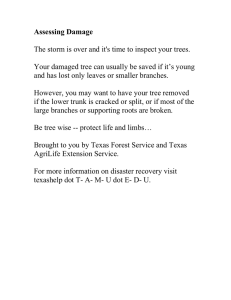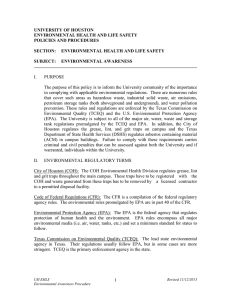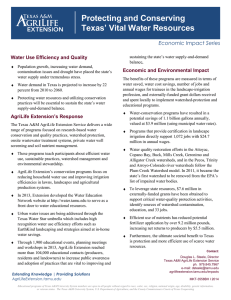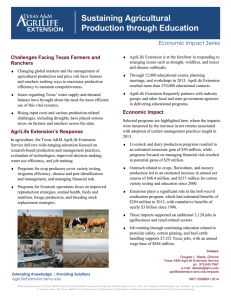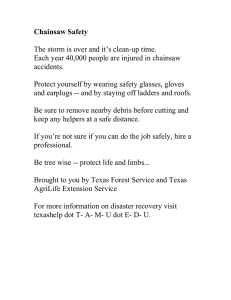BEST MANAGEMENT PRACTICE ANALYSIS - EDUCATION AND OUTREACH IMPLEMENTATION GOALS METHOD OF
advertisement
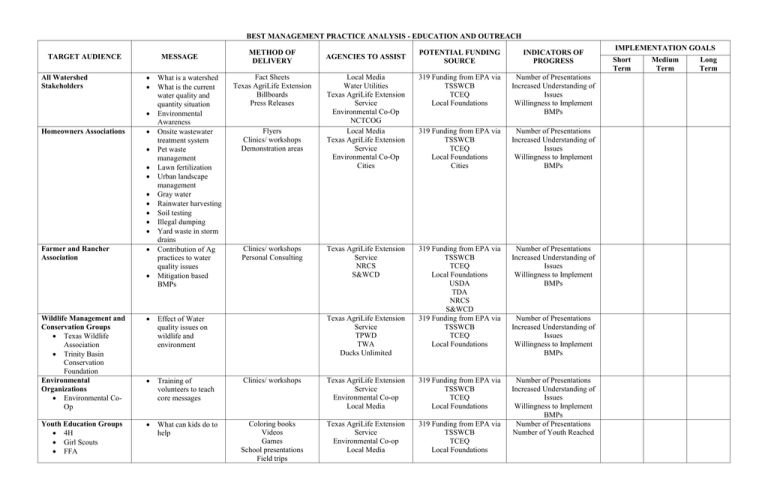
BEST MANAGEMENT PRACTICE ANALYSIS - EDUCATION AND OUTREACH TARGET AUDIENCE All Watershed Stakeholders MESSAGE Homeowners Associations Farmer and Rancher Association What is a watershed What is the current water quality and quantity situation Environmental Awareness Onsite wastewater treatment system Pet waste management Lawn fertilization Urban landscape management Gray water Rainwater harvesting Soil testing Illegal dumping Yard waste in storm drains Contribution of Ag practices to water quality issues Mitigation based BMPs METHOD OF DELIVERY Fact Sheets Texas AgriLife Extension Billboards Press Releases Flyers Clinics/ workshops Demonstration areas Clinics/ workshops Personal Consulting POTENTIAL FUNDING SOURCE INDICATORS OF PROGRESS Local Media Water Utilities Texas AgriLife Extension Service Environmental Co-Op NCTCOG Local Media Texas AgriLife Extension Service Environmental Co-Op Cities 319 Funding from EPA via TSSWCB TCEQ Local Foundations Number of Presentations Increased Understanding of Issues Willingness to Implement BMPs 319 Funding from EPA via TSSWCB TCEQ Local Foundations Cities Number of Presentations Increased Understanding of Issues Willingness to Implement BMPs Texas AgriLife Extension Service NRCS S&WCD 319 Funding from EPA via TSSWCB TCEQ Local Foundations USDA TDA NRCS S&WCD 319 Funding from EPA via TSSWCB TCEQ Local Foundations Number of Presentations Increased Understanding of Issues Willingness to Implement BMPs Number of Presentations Increased Understanding of Issues Willingness to Implement BMPs Number of Presentations Number of Youth Reached AGENCIES TO ASSIST Wildlife Management and Conservation Groups Texas Wildlife Association Trinity Basin Conservation Foundation Environmental Organizations Environmental CoOp Effect of Water quality issues on wildlife and environment Training of volunteers to teach core messages Clinics/ workshops Texas AgriLife Extension Service Environmental Co-op Local Media 319 Funding from EPA via TSSWCB TCEQ Local Foundations Youth Education Groups 4H Girl Scouts FFA What can kids do to help Coloring books Videos Games School presentations Field trips Texas AgriLife Extension Service Environmental Co-op Local Media 319 Funding from EPA via TSSWCB TCEQ Local Foundations Texas AgriLife Extension Service TPWD TWA Ducks Unlimited Number of Presentations Increased Understanding of Issues Willingness to Implement BMPs IMPLEMENTATION GOALS Short Term Medium Term Long Term Boy Scouts Gardeners and Homeowners Fishermen Small Acreage Landowners Church Organization Onsite wastewater treatment system Pet waste management Lawn fertilization Urban landscape management Gray water Rainwater harvesting Soil testing Illegal dumping Grass clippings leaves in storm drains Effect of water quality on fisheries Nutrient management Onsite wastewater treatment system Pet waste management Lawn fertilization Urban landscape management Gray water Rainwater harvesting Soil Testing Illegal Dumping “Creation care” Water bill stuffers Clinics/ workshops Personal Consulting Workshops/ clinics Environmental Co-Op materials Water Supply Corporations Local Businesses Feed Stores Box Stores Nurseries Marinas Incorporate watershed teaching into badge earning opportunities Workshops/ clinics Training of sales staff at nurseries and home and garden centers How business practices affect water quality Storage of fertilizer, pesticide, and Texas AgriLife Extension Service Environmental Co-op Local Media Master Gardner’s 319 Funding from EPA via TSSWCB TCEQ Local Foundations Texas AgriLife Extension Service TPWD TWA Ducks Unlimited Texas AgriLife Extension Service NRCS S&WCD 319 Funding from EPA via TSSWCB TCEQ Local Foundations 319 Funding from EPA via TSSWCB TCEQ Local Foundations USDA TDA NRCS S&WCD Number of Presentations Increased Understanding of Issues Willingness to Implement BMPs Texas AgriLife Extension Service Environmental Co-op Local Media TRWD 319 Funding from EPA via TSSWCB TCEQ Local Foundations 319 Funding from EPA via TSSWCB TCEQ Local Foundations 319 Funding from EPA via TSSWCB TCEQ Local Foundations Number of Presentations Number of Individuals Reached Texas AgriLife Extension Service Environmental Co-op Local Media Number of Presentations Increased Understanding of Issues Willingness to Implement BMPs Number of Presentations Number of Individuals Reached Number of Presentations Number of Individuals Reached Influential People and Organizations Elected officials at all levels Civic Organizations Media Personnel Chambers of Commerce Business and Community Leaders Developers herbicide inventory Effect of water quality on commerce, tourism, and property values (taxation) Development and support of model ordinances Meeting Presentations Fact Sheets Texas AgriLife Extension Service Environmental Co-op Local Media 319 Funding from EPA via TSSWCB TCEQ Local Foundations Number of Presentations Number of Individuals Reached Clinics/ workshops Personal Consulting Texas AgriLife Extension Service 319 Funding from EPA via TSSWCB TCEQ Local Foundations Number of Presentations Increased Understanding of Issues Willingness to Implement BMPs 6 steps of education and outreach: 1. Define goals and objectives 2. Identify target issues 3. Determine Message 4. Package message/ materials 5. Distribute educational material and message 6. Evaluation Goals and Objectives The Cedar Creek watershed educational program will share information regarding the status of the Cedar Creek reservoir and future condition scenarios. The activities of people living in the watershed and around the lake will dictate the water quality within the reservoir. An educational program will utilize key messages to empower residents to accept information describing the status of the reservoir and implement best management practices on their property to limit availability and transport of contaminants to the reservoir. Specific objectives to obtain this goal include: Increase public awareness regarding water quality in the cedar creek reservoir. Increase water literacy among residents within the cedar creek watershed. Identify groups within the watershed conducting environmental education programs. In cooperation with other Cedar Creek work groups develop educational strategies to increase awareness of contaminant sources and best management practices to limit contaminants reaching the reservoir.
